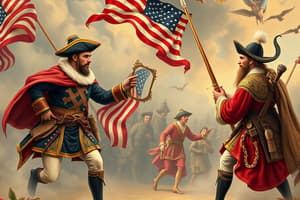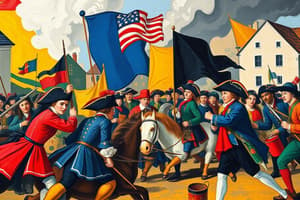Podcast
Questions and Answers
What was the purpose of using 'mask letters' in secret communications?
What was the purpose of using 'mask letters' in secret communications?
- To reveal a hidden message using a cut-out template. (correct)
- To make letters harder to forge.
- To encrypt messages with invisible ink.
- To create fake letters.
Lydia Darragh used secret compartments to convey messages by sewing them into the sleeves of her son's coat.
Lydia Darragh used secret compartments to convey messages by sewing them into the sleeves of her son's coat.
False (B)
Who was the officer that asked James Armistead to pose as a runaway slave?
Who was the officer that asked James Armistead to pose as a runaway slave?
Lafayette
Messages were sometimes hidden in compartments inside _______ and feathers.
Messages were sometimes hidden in compartments inside _______ and feathers.
Match the following individuals to their secret communication methods:
Match the following individuals to their secret communication methods:
What method did Major Benjamin Tallmadge develop to transmit messages during the American Revolution?
What method did Major Benjamin Tallmadge develop to transmit messages during the American Revolution?
The use of invisible ink allowed Patriot spies to inscribe messages that were visible to anyone reading the note.
The use of invisible ink allowed Patriot spies to inscribe messages that were visible to anyone reading the note.
What significant challenge did spies face during the American Revolution when transmitting messages?
What significant challenge did spies face during the American Revolution when transmitting messages?
The Culper Spy Ring used a numerical code book to transcribe messages about British troop activities in _______ City.
The Culper Spy Ring used a numerical code book to transcribe messages about British troop activities in _______ City.
Match the following methods of espionage with their descriptions:
Match the following methods of espionage with their descriptions:
Flashcards
Invisible Ink
Invisible Ink
A secret writing method using a substance that's invisible until heated or exposed to a chemical.
Mask Letters
Mask Letters
Secret messages hidden within seemingly innocent letters, revealed by placing a mask or template over the text.
Secret Hiding Places
Secret Hiding Places
Concealed locations for delivering secret messages, using everyday objects like hollowed-out quills or small compartments.
Lydia Darragh
Lydia Darragh
Signup and view all the flashcards
Loyalist Spies
Loyalist Spies
Signup and view all the flashcards
False Information
False Information
Signup and view all the flashcards
James Armistead
James Armistead
Signup and view all the flashcards
Espionage in the American Revolution
Espionage in the American Revolution
Signup and view all the flashcards
Ciphers/Codes
Ciphers/Codes
Signup and view all the flashcards
Major Benjamin Tallmadge
Major Benjamin Tallmadge
Signup and view all the flashcards
Numerical Code
Numerical Code
Signup and view all the flashcards
Culper Spy Ring
Culper Spy Ring
Signup and view all the flashcards
Invisible Ink
Invisible Ink
Signup and view all the flashcards
Loyalists
Loyalists
Signup and view all the flashcards
Patriots
Patriots
Signup and view all the flashcards
Study Notes
Espionage During the American Revolution
- Spies during the American Revolution used various methods to transmit information, predating modern technology like satellites and cameras.
Ciphers and Codes
- Loyalists and Patriots were neighbors in the colonies, making observation of activities easy.
- Spies reported activities to other spies.
- Major Benjamin Tallmadge created a numerical code (763 numbers representing words, names, and places) in 1778.
- This code was used by New York's Culper Spy Ring
- The code used a period to separate numbers to avoid confusion.
- Examples of coded messages like "Artillery is necessary on Long Island" were translated into a series of numbers.
- The code allowed for safe transmission but risked identification if intercepted.
Chemicals and Masks
- Invisible ink, made from ferrous sulfate and water or tannic acid, was used to hide messages in writing.
- The messages would only be visible when heated or treated with a certain chemical.
- General Washington advised using invisible ink on blank pages of old books, to decrease detection risks.
- Mask letters involved a hidden message within a seemingly normal letter, revealed with a separate mask.
- Mask-based messages were delivered in two parts, letter and mask, for enhanced security.
Secret Hiding Places
- Messages were "hidden in plain sight" with codes, invisible ink, and masks.
- Urgent, plain-text messages were sometimes sent in secret compartments in everyday objects.
- Lydia Darragh, a Patriot supporter, used this method by delivering messages hidden in buttons on her son's coat.
- British spies used hollowed-out quills and silver balls for messages.
Fakery and Laundry
- Spreading false information was an accepted espionage tactic.
- James Armistead, an enslaved African American Patriot soldier, successfully used deception to provide false information to the British, contributing to the victory at Yorktown.
- Armistead posed as a runaway slave and crossed British lines with fake information supplied by Lafayette, his officer.
Studying That Suits You
Use AI to generate personalized quizzes and flashcards to suit your learning preferences.
Description
Explore the fascinating world of espionage during the American Revolution, focusing on the methods spies used to communicate and gather intelligence. Learn about ciphers, codes, and the clever use of invisible ink to secure messages in a time of conflict. Discover how innovative techniques helped shape the outcome of the revolution.




